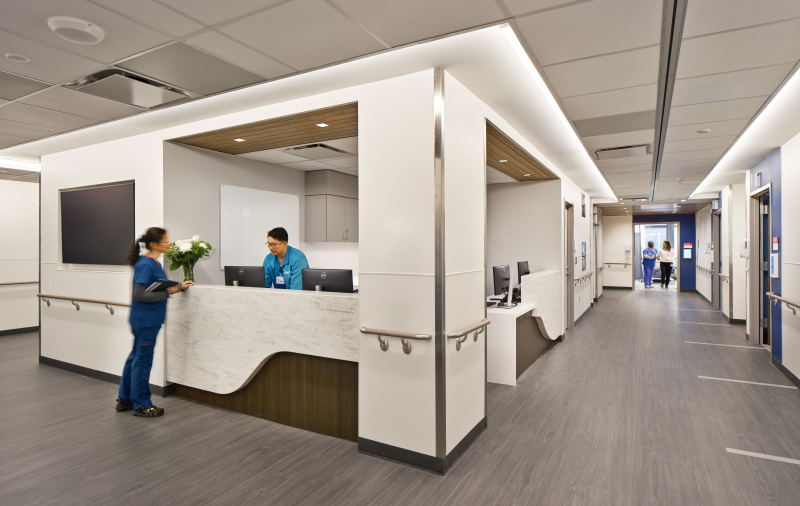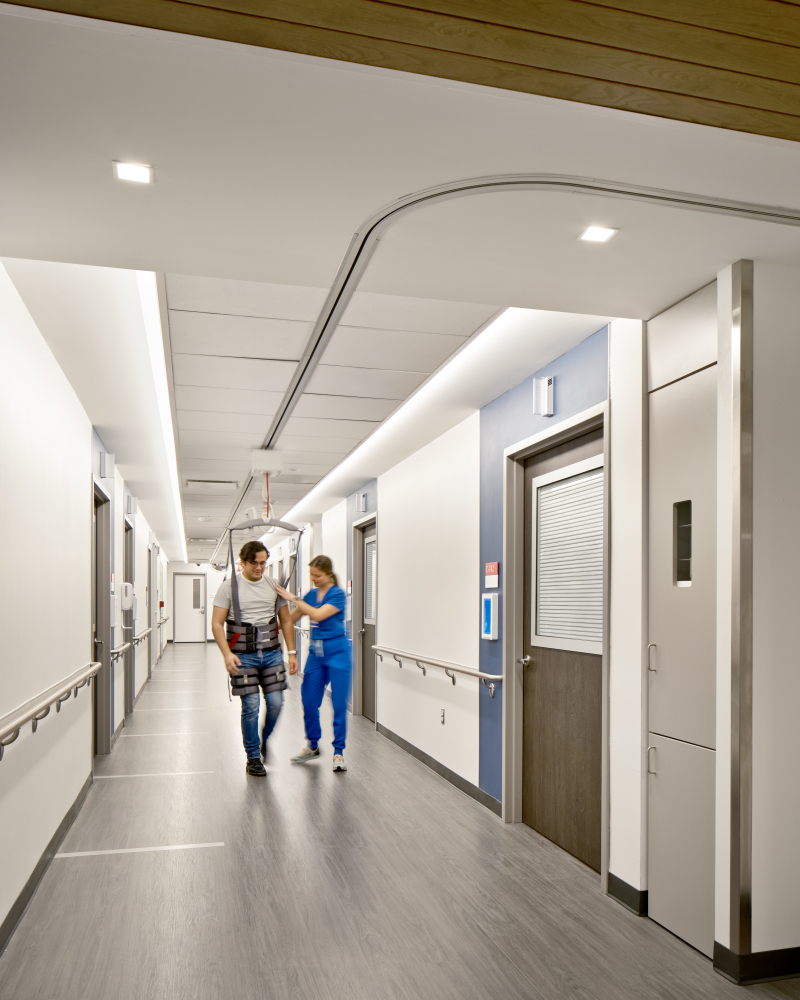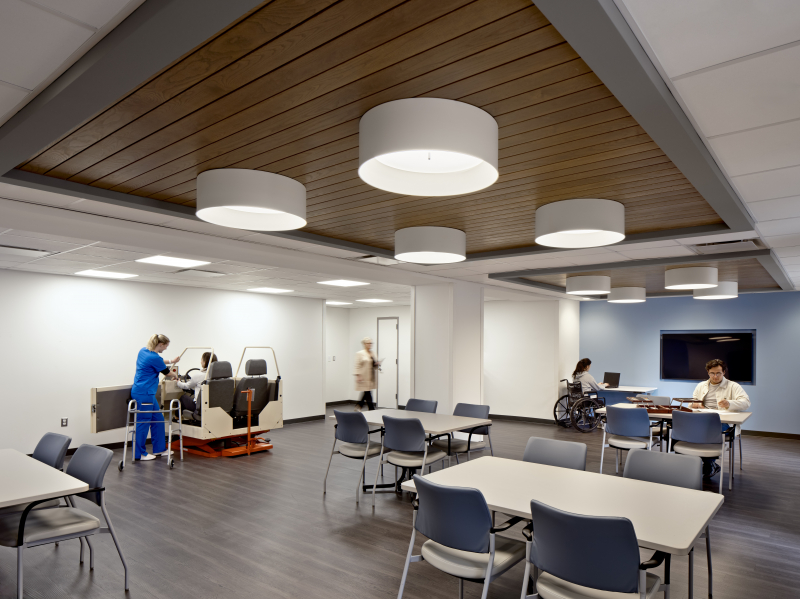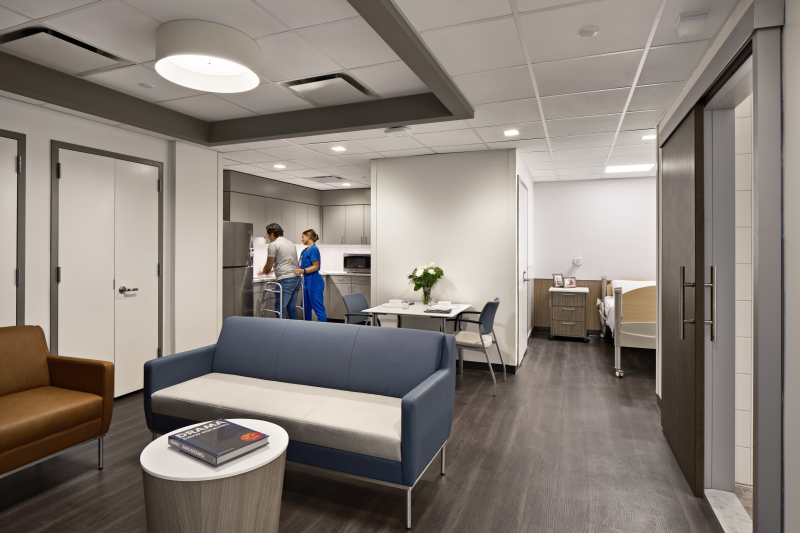Mount Sinai Rehabilitation Center
New York, NY
Category: 2025 Healthcare, Unique Installation Challenge
Architect: HKS
Designer: HKS
Starnet Member: Consolidated Flooring
Starnet Preferred Vendors: Ardex, CLIMIT, TEC, AHF, ECOSurfaces, Flexco, Roppe, Tarkett, Johnsonite By Tarkett
Project Strategy
The Mount Sinai Department of Rehabilitation Medicine and Human Performance relocated the inpatient rehabilitation program from The Mount Sinai Hospital to Mount Sinai Morningside, which presented a unique opportunity to create a healing environment specifically tailored to the needs of patients recovering from traumatic brain and spinal cord injuries. This ambitious undertaking, while presenting significant challenges, ultimately succeeded through innovative solutions and a steadfast commitment to patient-centered care.
From the outset, the design team faced the complex task of uniting and maintaining continuity with the four interconnected and existing Mount Sinai Morningside buildings - each from different eras, with their own architectural quirks. Misaligned corridors, varying ceiling heights, and distinct column grids threatened to disrupt the flow and cohesion of the space. HKS and Consolidated Flooring used strategic flooring patterns and thoughtful lighting design to create a sense of harmony and intuitive navigation, successfully unifying the space.
Further complicating the design process was the need to cater to the specific needs of the patient population. Initial plans for a calming color palette of earth tones were abandoned after consultations revealed that such hues could trigger anxiety and disorientation in individuals with brain injuries. Instead, the team pivoted to a more contrasting scheme with deeper blues, grays, and wood tones, incorporating subtle variations to aid in spatial orientation and reduce visual discomfort. One of the ways this was achieved was by highlighting doorways and entry points through ground markers that easily signaled a portal to another room or space.
Adding to the project's intricacy, the originally specified flooring manufacturer unexpectedly ceased operations. This required a rapid and thorough reselection process to identify a replacement product that met the stringent performance and aesthetic requirements while adhering to the project's timeline. After careful consideration and assessment, the team landed on Resilient Flooring and Wall Base from Tarkett as well as a rubber backed Resilient tile from ECO surfaces. The final selection had to withstand the constant impact of wheelchairs, walkers, and other assistive devices, ensuring longevity in this demanding healthcare environment.
Throughout the construction process, minimizing disruption to patient care remained a top priority. Meticulous planning and scheduling were essential to control dust, noise, and access restrictions, ensuring that the hospital could continue to operate smoothly.
Despite these challenges, the HKS and Consolidated Flooring team persevered, driven by a commitment to create a space that fosters healing and promotes patient well-being. The final result is a testament to the power of collaboration, innovation, and a patient-centric approach. Flooring patterns guide patients through the space, contrasting colors and tactile cues aid in navigation, and indirect lighting creates a calming ambiance. Corridors have been transformed into therapeutic spaces, encouraging patients to practice walking and socialize while engaging in their rehabilitation journey.
The Mount Sinai Rehabilitation Center stands as a shining example of how design can positively impact patient outcomes. By embracing challenges and prioritizing the unique needs of the patient population, HKS and Consolidated Flooring created a space that is not only functional and aesthetically pleasing, but also supportive and empowering for both the patients and caregivers. This project exemplifies the transformative potential of healthcare design and the importance of collaboration in achieving exceptional results.
Note, in accordance with Mount Sinai’s policies, Consolidated Flooring was selected after a careful and competitive Request for Proposal process.
Unique Installation Challenge Strategy
The Mount Sinai Department of Rehabilitation Medicine and Human Performance relocated the inpatient rehabilitation program from The Mount Sinai Hospital to Mount Sinai Morningside, which presented a unique opportunity to create a healing environment specifically tailored to the needs of patients recovering from traumatic brain and spinal cord injuries. This ambitious undertaking, while presenting significant challenges, ultimately succeeded through innovative solutions and a steadfast commitment to patient-centered care.
From the outset, the design team faced the complex task of uniting and maintaining continuity with the four interconnected and existing Mount Sinai Morningside buildings - each from different eras, with their own architectural quirks. Misaligned corridors, varying ceiling heights, and distinct column grids threatened to disrupt the flow and cohesion of the space. HKS and Consolidated Flooring used strategic flooring patterns and thoughtful lighting design to create a sense of harmony and intuitive navigation, successfully unifying the space.
Further complicating the design process was the need to cater to the specific needs of the patient population. Initial plans for a calming color palette of earth tones were abandoned after consultations revealed that such hues could trigger anxiety and disorientation in individuals with brain injuries. Instead, the team pivoted to a more contrasting scheme with deeper blues, grays, and wood tones, incorporating subtle variations to aid in spatial orientation and reduce visual discomfort. One of the ways this was achieved was by highlighting doorways and entry points through ground markers that easily signaled a portal to another room or space.
Adding to the project's intricacy, the originally specified flooring manufacturer unexpectedly ceased operations. This required a rapid and thorough reselection process to identify a replacement product that met the stringent performance and aesthetic requirements while adhering to the project's timeline. After careful consideration and assessment, the team landed on Resilient Flooring and Wall Base from Tarkett as well as a rubber backed Resilient tile from ECO surfaces. The final selection had to withstand the constant impact of wheelchairs, walkers, and other assistive devices, ensuring longevity in this demanding healthcare environment.
Throughout the construction process, minimizing disruption to patient care remained a top priority. Meticulous planning and scheduling were essential to control dust, noise, and access restrictions, ensuring that the hospital could continue to operate smoothly.
Despite these challenges, the HKS and Consolidated Flooring team persevered, driven by a commitment to create a space that fosters healing and promotes patient well-being. The final result is a testament to the power of collaboration, innovation, and a patient-centric approach. Flooring patterns guide patients through the space, contrasting colors and tactile cues aid in navigation, and indirect lighting creates a calming ambiance. Corridors have been transformed into therapeutic spaces, encouraging patients to practice walking and socialize while engaging in their rehabilitation journey.
The Mount Sinai Rehabilitation Center stands as a shining example of how design can positively impact patient outcomes. By embracing challenges and prioritizing the unique needs of the patient population, HKS and Consolidated Flooring created a space that is not only functional and aesthetically pleasing, but also supportive and empowering for both the patients and caregivers. This project exemplifies the transformative potential of healthcare design and the importance of collaboration in achieving exceptional results.
Note, in accordance with Mount Sinai’s policies, Consolidated Flooring was selected after a careful and competitive Request for Proposal process.






